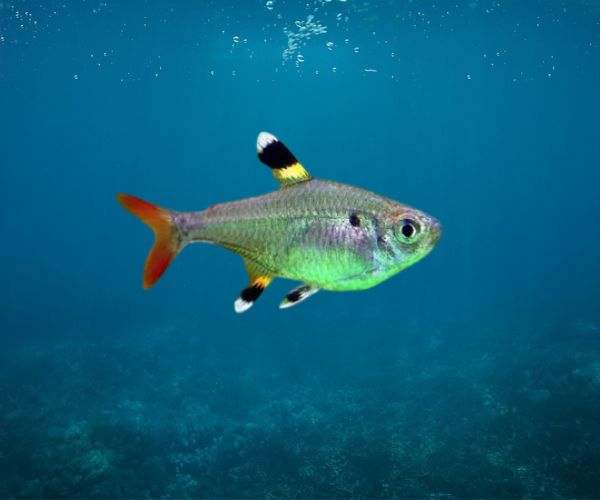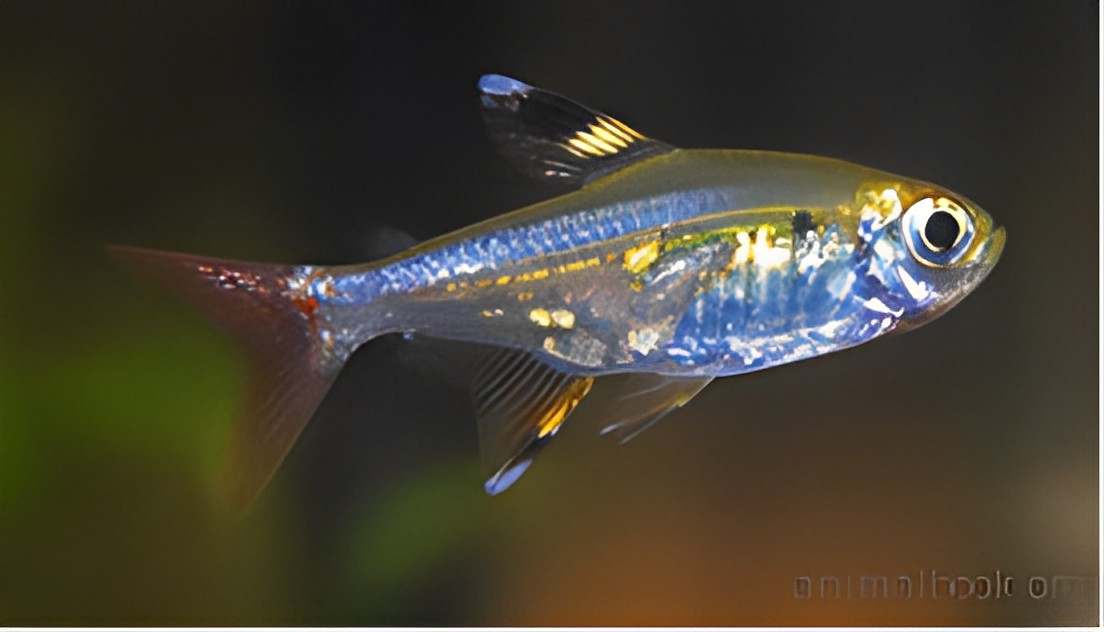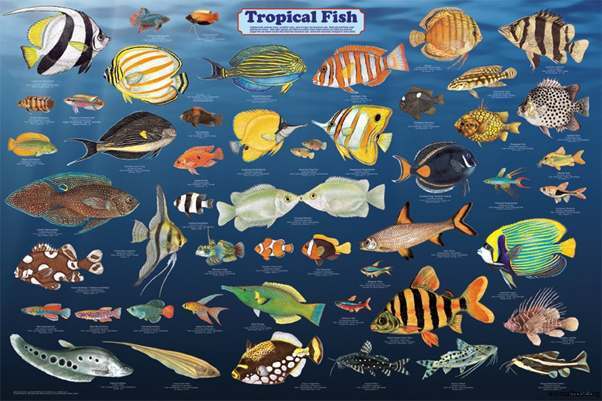The X-ray fish, also known as the X-ray tetra, is a captivating and peculiar species of freshwater fish native to the beautiful South American regions.
This article covers the extraordinary features and characteristics of the X-ray fish, shedding light on its unique biology, habitat, and popularity in the aquarium trade.
The Enigmatic X-ray Fish: Unveiling Its Physical Attributes
The X-ray fish, scientifically known as Pristella maxillaris, boasts an astounding feature that sets it apart from other fish species—it has translucent skin that allows light to pass through most parts of its body.
This extraordinary characteristic enables observers to literally see through the X-ray fish, revealing its internal organs and skeletal structure. Such a phenomenon has earned it the intriguing name of “X-ray fish.”

Aesthetic Appeal: The Vibrant Coloration of the X-Ray Fish
The X-ray fish exhibits a stunning combination of colors on its fins, featuring bands of yellow, black, and white. Its tail fin, adorned with a reddish hue, adds to its visual appeal.
Additionally, a distinctive black spot is often present behind the X-ray fish’s eye, accentuating its unique appearance. These captivating colors make it a popular choice for aquarium enthusiasts worldwide.
Habitat and Distribution: Exploring the Amazon and Orinoco River Basins
The X-ray fish is predominantly found in the lush waters of the Amazon and Orinoco river basins in South America. These freshwater ecosystems provide an ideal environment for the X-ray fish to thrive.
The ample availability of water insects and other small animals serves as a bountiful food source for this species, contributing to its survival and proliferation.
Dietary Preferences: What Do X-Ray Fish Eat?
As opportunistic feeders, X-ray fish consume a diverse diet consisting of water insects, small crustaceans, and other tiny aquatic creatures.
Their omnivorous nature allows them to adapt to various food sources available in their natural habitat. In aquarium settings, providing a balanced diet ensures their health and longevity.
X-Ray Fish in the Aquarium Trade: A Popular Attraction
The remarkable appearance and manageable size of the X-ray fish make it a favorite among aquarium enthusiasts and hobbyists. The ability to observe the inner workings of the X-ray fish makes it an intriguing and educational addition to home aquariums.
However, it is essential to maintain proper tank conditions and water quality to ensure the well-being of these captivating creatures.

Aquarium Care: Creating an Optimal Environment for X-Ray Fish
To accommodate the needs of X-ray fish in an aquarium setting, certain considerations should be taken into account:
Tank Size and Setup
X-ray fish are relatively small, growing to less than 2 inches in length. A tank with a capacity of at least 10 gallons is sufficient for a small group of these fish.
Providing ample swimming space and the inclusion of hiding spots with live plants mimic their natural habitat and offer a stress-free environment.
Water Parameters
Maintaining appropriate water parameters is crucial for the health of X-ray fish. The water temperature should be kept between 72°F to 82°F (22°C to 28°C), with a slightly acidic to neutral pH range of 6.0 to 7.5.
Regular water changes are essential to ensure water quality and prevent the buildup of harmful substances.
Compatible Tankmates
When selecting tankmates for X-ray fish, opt for peaceful and non-aggressive species that thrive in similar water conditions.
Tetras, rasboras, and small catfish are suitable companions that won’t pose a threat to the X-ray fish.
Balanced Diet
In a confined environment like an aquarium, providing a varied diet is essential for X-ray fish. Offer a mix of high-quality flake food, pellets, and frozen or live foods such as brine shrimp and bloodworms.
A balanced diet ensures their well-being and enhances their vibrant coloration.
RELATED ARTICLES:
- Whale: The Majestic Giants of the Deep

- X-Ray Fish – A Fascinating Freshwater Species

- Tropical Fish: A Colorful Underwater Adventure!

Captivating X-Ray Fish Behavior: Schooling and Shoaling
X-ray fish are social creatures that exhibit a fascinating behavior called schooling or shoaling.
In their natural habitat, they form large groups to protect themselves from predators and to increase their chances of finding food.
In an aquarium, it’s recommended to keep X-ray fish in groups of six or more to replicate this behavior. A cohesive group of X-ray fish creates a captivating sight, showcasing their synchronized movements and interactions.
Breeding the X-Ray Fish: A Glimpse into Their Reproduction Process
The breeding behavior of X-ray fish is intriguing for aquarium enthusiasts who wish to observe their natural instincts in action.
To encourage breeding, a separate breeding tank with gentle filtration and live plants can be set up. Introducing a well-conditioned pair or a small group of X-ray fish into the breeding tank can trigger the courtship and spawning process.
Conservation Status: Protecting the X-Ray Fish in the Wild
As with many species of wildlife, the X-ray fish faces threats to its natural habitat due to human activities, such as deforestation, water pollution, and habitat destruction.
Responsible aquarium keeping and support for conservation efforts help ensure the continued existence of these beautiful fish in their native environments.
Read: Tropical Fish: A Colorful Underwater Adventure!
Conclusion
In conclusion, the X-ray fish, or X-ray tetra, remains a fascinating and captivating species of freshwater fish found in the Amazon and Orinoco river basins of South America.
Its ability to allow light to pass through its body, vibrant coloration, and intriguing behavior make it a sought-after addition to aquariums worldwide.
By understanding their needs and providing a suitable environment, aquarium enthusiasts can enjoy the mesmerizing sight of X-ray fish schooling gracefully in their tanks.
As we appreciate the beauty of this unique fish, let us also strive to protect its natural habitats and ensure its survival for generations to come.
You can visit Wikipedia to learn more about the x-ray fish.
FAQs
What is an X-ray fish?
The X-ray fish, scientifically known as Pristella maxillaris, is a captivating freshwater species native to South America. It is called “X-ray fish” due to its translucent skin, which allows observers to see through its body, revealing internal organs and skeletal structure.
Where can X-ray fish be found in the wild?
X-ray fish are predominantly found in the freshwater ecosystems of the Amazon and Orinoco river basins in South America. These regions provide an ideal habitat for their survival and proliferation.
What do X-ray fish eat?
X-ray fish are opportunistic feeders with an omnivorous diet. They consume water insects, small crustaceans, and other tiny aquatic creatures in the wild. In aquariums they survive on varied diet, including high-quality flake food, pellets, and live or frozen foods like brine shrimp and bloodworms.
What makes X-ray fish popular in the aquarium trade?
X-ray fish’s unique appearance and manageable size make them popular among aquarium enthusiasts. The ability to see through their bodies adds intrigue, and their vibrant coloration adds visual appeal to aquariums.
How should I care for X-ray fish in an aquarium?
To care for X-ray fish in an aquarium, ensure a tank size of at least 10 gallons for a small group. Maintain appropriate water parameters with a temperature between 72°F to 82°F (22°C to 28°C) and a slightly acidic to neutral pH range of 6.0 to 7.5. Provide hiding spots with live plants and choose compatible tankmates such as tetras, rasboras, and small catfish. Offer a balanced diet to promote their well-being.
Can I keep X-ray fish alone, or do they prefer to be in groups?
X-ray fish are social creatures and prefer to be kept in groups. Keeping them in groups of six or more allows them to exhibit their natural schooling behavior, creating a captivating sight in the aquarium.
How can I breed X-ray fish in captivity?
To encourage breeding, set up a separate breeding tank with gentle filtration and live plants. Introduce a well-conditioned pair or a small group of X-ray fish into the tank to trigger the courtship and spawning process.
Are X-ray fish endangered?
As of my last update in September 2021, X-ray fish were not classified as an endangered species. However, like many other species, they face threats to their natural habitat due to human activities. Responsible aquarium keeping and support for conservation efforts help protect these beautiful fish in their native environments.
Can X-ray fish live with other fish species in the same tank?
Yes, X-ray fish can coexist with other peaceful and non-aggressive fish species that thrive in similar water conditions. Tetras, rasboras, and small catfish are some suitable tankmates for X-ray fish.
Are X-ray fish suitable for beginners in the aquarium hobby?
Yes, X-ray fish are generally suitable for beginners due to their relatively easy care requirements and peaceful nature. However, as with any fish species, responsible ownership and commitment to providing a suitable environment are essential for their well-being.

Leeisha
Leeisha is an enthusiastic content creator and devoted writer who finds solace in the world of animals. With a passion for reading, she weaves captivating tales, evoking emotions and shedding light on wildlife. Leeisha’s words resonate, reminding us of the profound beauty and significance of the creatures we share our planet with.





